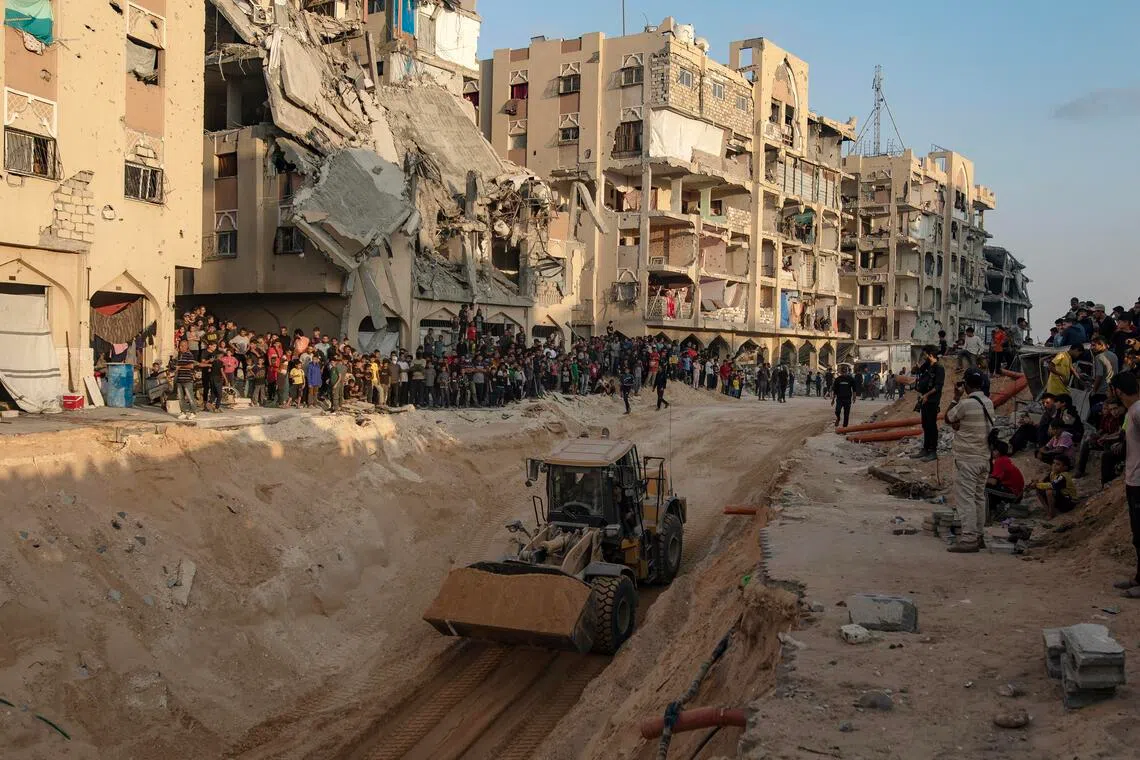UN aid chief foresees ‘massive job’ ahead on tour of ruined Gaza
Sign up now: Get ST's newsletters delivered to your inbox

An excavator at a site where the bodies of Israeli hostages are believed to be buried.
PHOTO: EPA
Follow topic:
JERUSALEM – The United Nations’ aid chief took stock of the monumental task of restoring basic necessities in the devastated Gaza Strip on Oct 18, as Israel and Hamas exchanged more human remains.
In a short convoy of white UN jeeps, relief coordinator Tom Fletcher and his team wound their way through the twisted rubble of shattered homes to inspect a wastewater treatment plant in Sheikh Radwan, north of Gaza City.
“I drove through here seven or eight months ago when most of these buildings were still standing... This is a vast part of the city, just a wasteland, and it’s absolutely devastating to see,” he said.
The densely packed cities of the Gaza Strip, home to more than two million Palestinians, have been reduced to ruins by two years of bombardment and intense fighting between Hamas and the Israeli army.
Just over a week since US President Donald Trump helped broker a truce
Hamas has returned the final 20 surviving hostages it was holding and has begun to hand over the remains of another 28 who died.
Late on Oct 17, it turned over a set of remains
On Oct 18, in line with the terms of the ceasefire deal, Israel returned the bodies of 15 more Palestinians to Gaza, the Health Ministry in the Hamas-run territory said.
Digging latrines
Surveying the damaged pumping equipment and a grim lake of sewage at the Sheikh Radwan wastewater plant, Mr Fletcher said the task ahead for the UN and aid agencies was a “massive, massive job”.
The British diplomat said he met residents returning to destroyed homes trying to dig latrines in the ruins.
“They’re telling me that most of all, they want dignity,” he said. “We’ve got to get the power back on so we can start to get the sanitation system back in place.
“We have a massive 60-day plan now to surge in food, get a million meals out there a day, start to rebuild the health sector, bring in tents for the winter, get hundreds of thousands of kids back into school.”
According to figures supplied to mediators by the Israeli military’s civil affairs agency and released by the UN humanitarian office, some 950 trucks carrying aid and commercial supplies crossed into Gaza from Israel on Oct 16.
Relief agencies have called for the Rafah border crossing from Egypt to be reopened to increase the flow of food, fuel and medicine, and Turkey has a team of rescue specialists waiting at the border to help find bodies in the rubble.
Some violent incidents have taken place despite the ceasefire. Gaza’s civil defence agency, which operates under Hamas authority, said on Oct 18 that it had recovered the bodies of nine Palestinians from the Shaaban family after Israeli troops opened fire on a bus.
The military said it fired on a vehicle that approached the so-called “yellow line”, to which its forces withdrew under the terms of the ceasefire.
“The troops fired warning shots towards the suspicious vehicle, but the vehicle continued to approach the troops in a way that caused an imminent threat to them,” the military said.
“The troops opened fire to remove the threat, in accordance with the agreement.”
Hostage remains
Israel’s Prime Minister Benjamin Netanyahu approved the ceasefire but is under pressure at home to restrict access to Gaza until the remaining bodies of the hostages taken during Hamas’ attacks have been returned.
On Oct 18, his office confirmed that the latest body, returned by Hamas via the Red Cross late on Oct 17, was identified as Mr Margalit, an elderly farmer who was known to his friends at the Nir Oz kibbutz as “Churchill”.
“He was a cowboy at heart, and for many years managed the cattle branch and the horse stables of Nir Oz,” said the Hostages and Missing Families Forum, a support group founded by relatives of the hostages. “On Oct 7, he went out to feed his beloved horses and was kidnapped from the stable.”
Mr Margalit had been married with three children and three grandchildren. His daughter Nili Margalit, also taken hostage, was freed during the war’s first brief truce in November 2023.
In a statement about Mr Margalit, Mr Netanyahu’s office said: “We will not compromise... and will spare no effort until we return all of the fallen abductees, down to the last one.”
Hamas spokesman Hazem Qassem said on Oct 17 that the group “continues to uphold its commitment to the ceasefire agreement... and it will continue working to complete the full prisoner exchange process”.
Under the ceasefire agreement between Israel and Hamas, negotiated by Mr Trump and regional mediators, the Palestinian militant group has returned all 20 surviving hostages and the remains of 10 out of 28 deceased ones. AFP

